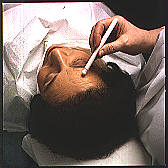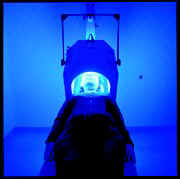|
|
|
Actinic Keratosis (Pre-Cancer) - Patient Information
What is actinic keratosis?
Actinic keratosis is formed of abnormal cells which are confined to the top layer of the skin (epidermis). Actinic keratoses usually develop in skin areas that are exposed to sun such as face, scalp, ears, arms, and hands. They are red, scaly areas which feel rough to the touch.
Who is at risk from actinic keratosis and how common is it ?
Actinic keratosis often occurs in people:
- with fair skin (and/ or red hair)
- who have had lots of exposure to the sun earlier in life
- who are older than 45
- of male gender, due to the fact that more men than women have outdoor occupations. Nevertheless women get actinic keratosis almost as often as men, in particular as they grow older.
People with dark skin rarely get actinic keratosis. The prevalence of actinic keratosis in a study in Australia estimated that 40 to 50 % of the population 40 years and older is affected. Other studies in Australia and the USA have reported lower figures, such as a prevalence of 11 to 26% of the population. A study done in Great Britain revealed that 15.4 % of men and 5.9% of women over the age of 40 had actinic keratosis. With increasing age (70 years and above) the prevalence rises steeply to 34.1% in men and 18.2% in women. This study showed that even a "normal" dose of sun exposure is sufficient enough to cause skin damage. The fact is that the prevalence in countries with high UV radiation and a fair skinned population is higher than in countries with a low level of UV radiation or a population with mainly dark skin.
What causes actinic keratoses and how do they develop?
There are several factors known to cause actinic keratosis. Probably the most important factor is the genetically defined individual skin type. Fair skin in combination with chronic or excessive exposure to sunlight is the main cause of actinic keratosis (outdoor work, worship the sun during vacation). The UV radiation of the sun has an impact on the genetic material of the cells in the epidermal layer . It causes a change in the genetic code which than transforms normal cells into abnormal or atypical cells. Little by little these abnormal cells replace the normal epidermal layer and lead to a disorder of the hardening process of the skin.
Actinic keratosis can also emerge from exposure to cancer-causing substances (carcinogenic substances) such as arsenic, X-ray radiation.
How to spot actinic keratosis
The affected area has to be carefully examined by a dermatologist. Frequently actinic keratoses are better felt than seen. Since actinic keratoses may resemble other skin disorders, and they cannot always be differentiated from squamous cell carcinoma, a piece of the lesion sometimes must be removed for further examination.
What does it look like?
Actinic keratosis can have many forms. Usually it appears as a round, oval or rather irregular patch which may at first be of a few millimeters in diameter and then grow up to 1 - 2 centimeters in diameter. The lesion may look red and most of the times have a scaly to rough horny surface. Besides reddening of the area the scaly surface may appear yellowish or brownish.
In any case if you discover an abnormal change on your skin which even might be growing or bleeding seek the advise of a dermatologist!
How to prevent actinic keratosis
To prevent actinic keratosis from developing effective UVA/UVB sunscreens on sun exposed areas should be used. Try to stay out of the sun between 11am and 3pm since UV radiation is strongest around this time of day. If you spend time outdoors you should wear a broad-brimmed hat and sun protective clothing such as a long sleeved shirt and long pants.
Children need special care If you have children always have in mind that the amount of UV radiation gathered early in life will increase the risk of developing actinic keratosis or skin cancer dramatically. So please take action and protect your child from sunlight.
Is it really actinic keratosis?
There are many skin diseases that may look similar to AK. Just because you have a rough spot on your skin does not mean you have cancer, yet it is something that should be taken seriously. If you have noticed a strange looking area of skin please see your dermatologist or doctor.
What could go wrong?
Danger of squamous cell carcinoma
If actinic keratosis is not discovered in time it carries the risk of developing into squamous cell carcinoma which is a rather aggressive and destroying skin cancer. So if you discover an area of your skin that is red and scaly and you are not sure what it may be go and see a dermatologist because actinic keratosis may look harmless and may not hurt but it is a serious condition which needs to be treated.
I have actinic keratosis what can I do?
Once you have been diagnosed with actinic keratosis there are several effective treatments to choose from. However to decide which treatment may best apply to your specific situation should be discussed with your doctor.
Cryosurgery
Cryosurgery is the most common treatment for actinic keratosis. Here liquid nitrogen is applied to the affected surface with a cotton tip applicator or spray device. Liquid nitrogen is extremely cold (-195,8 °C = -320,44 °F) and will cause death of all cells of this area.
Advantages of the treatment
- It is a highly effective treatment.
- It is a quick procedure.
- It only requires one or two visits to the doctor.
- In general it is a rather cheap treatment. (?)
Disadvantages of the treatment
- The treatment causes discomfort and/or pain.
- Due to freezing the skin may presumably react with blisters, reddening, swelling or a change of color in skin patches.
- An infection may occur due to delayed wound-healing.
- There is a risk of scarring.
Curettage
Curettage describes the scraping away of a superficial skin disorder. Usually a scalpel or another sharp device, called a curette, is used for scraping.
Advantages of the treatment
- It is an effective treatment.
Disadvantages of the treatment
- The treatment usually requires a local anesthetic.
- Occasionally, a change of color or an infection of the skin may occur.
- There is a possibility of scarring.
Topical 5-fluorouracil
Topical 5-fluorouracil, also called 5-FU, is a cream that is applied to the skin. It contains a drug that will cause cell death by binding to cellular DNA.
Advantages of the treatment
- It is a highly effective treatment.
- It has good cosmetic results.
Disadvantages of the treatment
- In general the treatment is rather painful and disfiguring due to inflammation and reddening of the area. If a large area is treated it may be quite disfiguring.
- The cream has to be applied over quite a long period (appoximately 2 to 4 weeks).
- The success of treatment depends on patient cooperation.
Photodynamic therapy
Photodynamic therapy is based on a chemical reaction of a drug induced by light that will kill abnormal cells. The drug will be absorbed by the skin cells and will cause sensitivity of the skin towards light of a certain color/wavelenght. If light is induced to the treated area a chemical reaction is initiated that will lead to the death of diseased cells. The drug most often used is called aminolevulinic acid (ALA). It is applied to the skin as a solution with an applicator or as a cream. (see photos - courtesy of DUSA Pharmaceuticals, Inc.) Further information are available at LEVULAN
|
 |
 |
 |
 |
Advantages of the treatment
The treatment is highly effective and does not require surgery.
It has excellent cosmetic results.
Usually the treated areas heal fast (within two weeks).
Only one or two treatments are necessary.
Disadvantages of the treatment
- The treatment will cause a typical photodynamic reaction such as stinging, burning, itching, reddening and/or swelling.
- Pain during irradiation may require anesthesia
|
Other treatments
Besides the treatments mentioned above there are several others in use.
Medication
There are several drugs used to treat actinic keratosis. These are basically divided into drugs that are applied to the skin – so-called topical drugs – and drugs that need to be taken orally, so-called systemical drugs.
Topical drugs such as:
Salicylic acid, topical retinoids, alpha hydroxy acids, topical masoprocol, topical tubercidin, chemical or cryosurgical peel, imiquimod (experimental)
Systemic drugs such as:
Oral retinoids (often in combination with 5-FU), Interferon
Surgery
Excisional surgery is an intervention where the lesion is simply cut out, whereas dermabrasion is an intervention where the top layers of the affected skin area are ground away.
Laser
Affected cells are destroyed by the laser.
What are the chances of being cured?
If actinic keratoses are treated properly at an early stage, the chances of getting cured are very high, although new lesions may arise in other parts of sun-damaged skin. If left untreated, actinic keratoses may either disappear spontaneously, persist, or develop into squamous cell carcinoma, a skin tumor which can also affect other body organs because of its potential to metastasize. It is not possible to foresee which actinic keratoses will develop into this malignant skin tumour.
|
|

|
|

|
|
